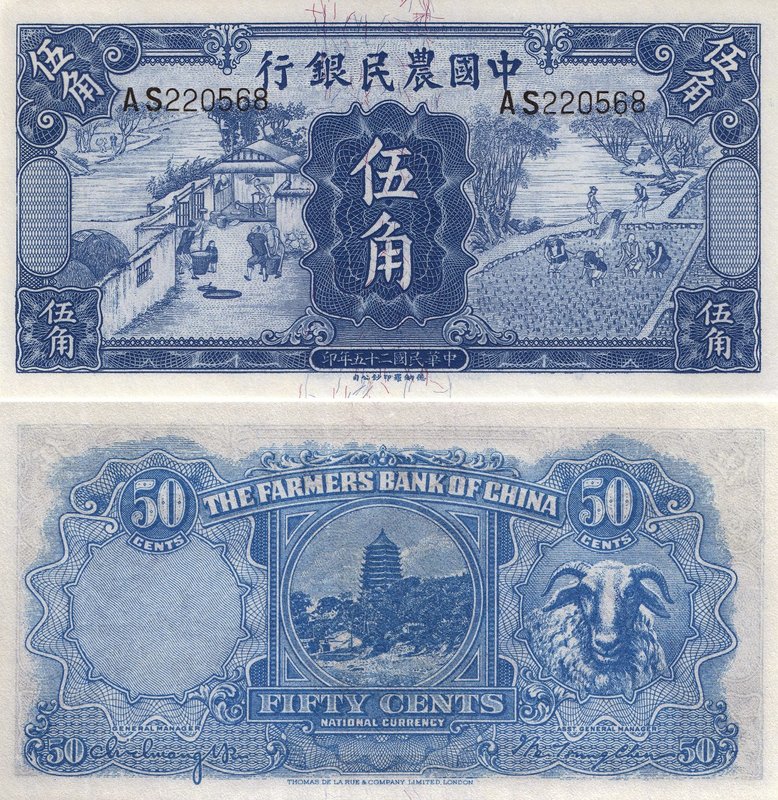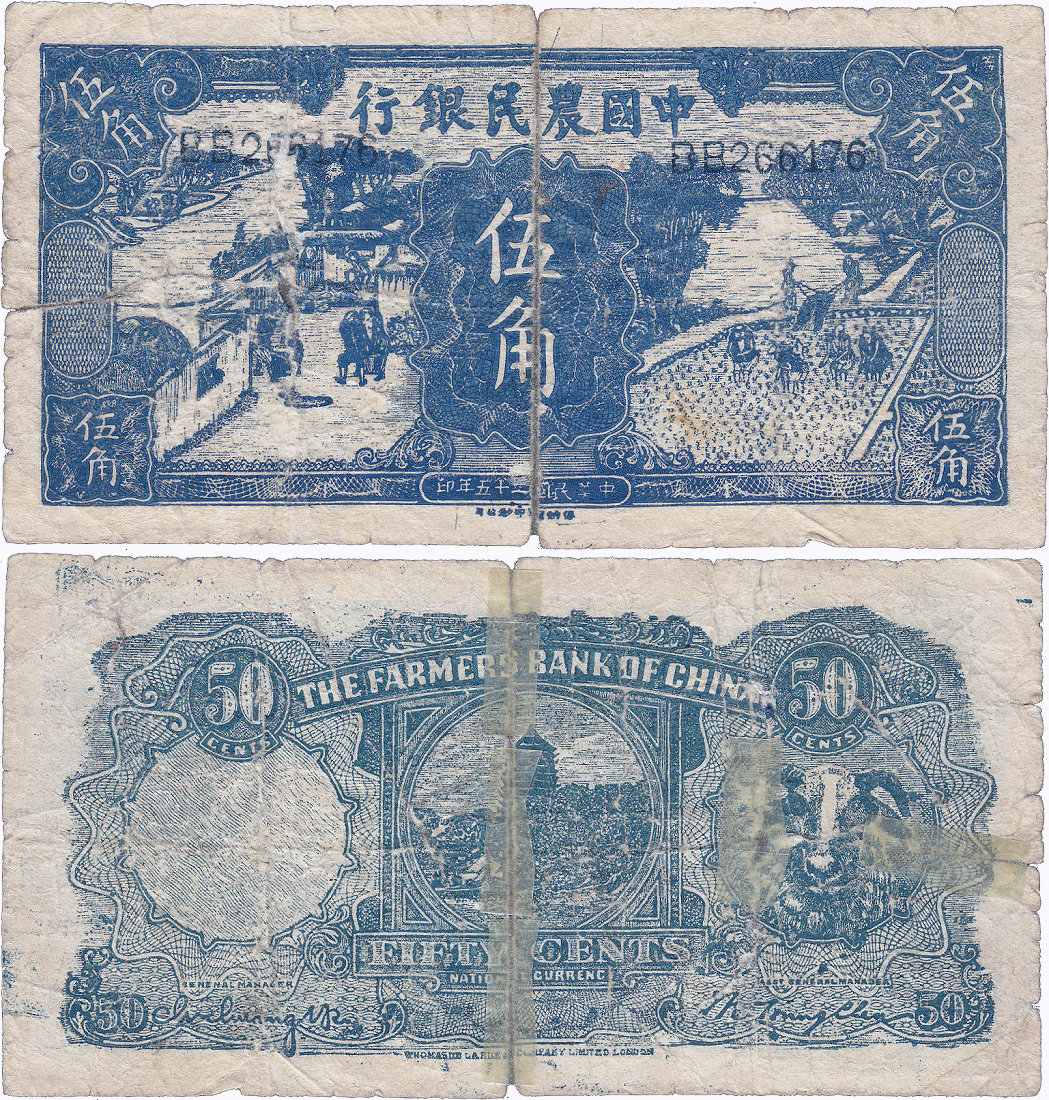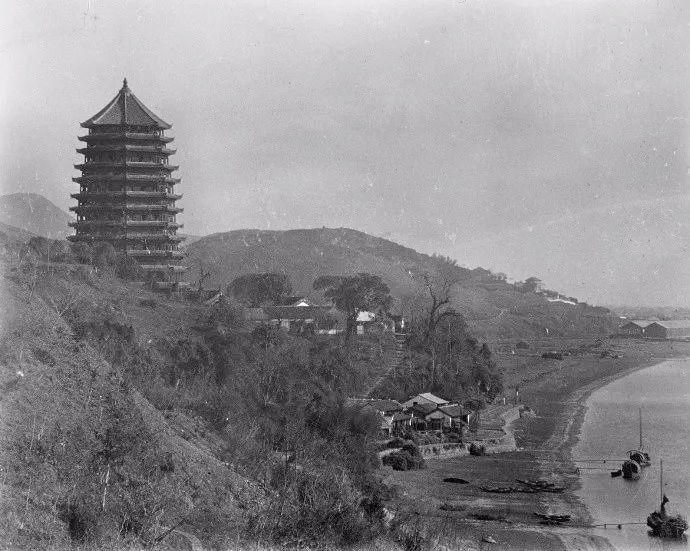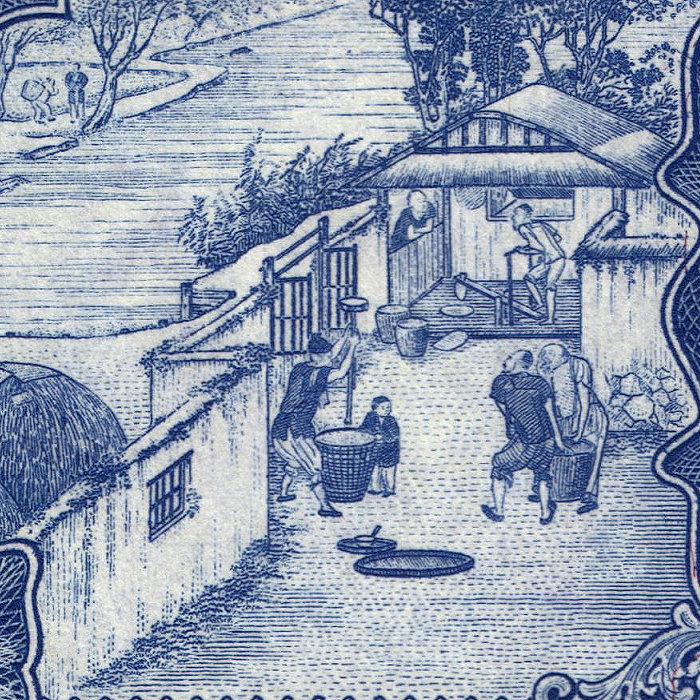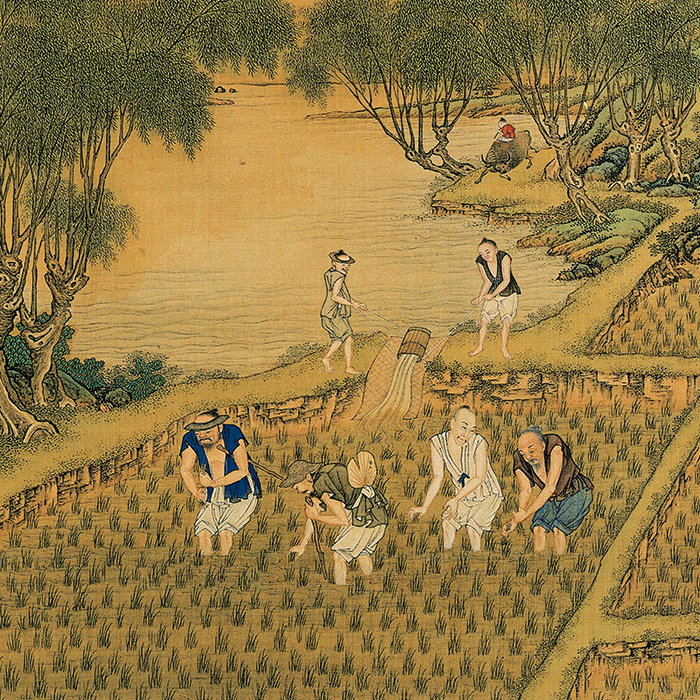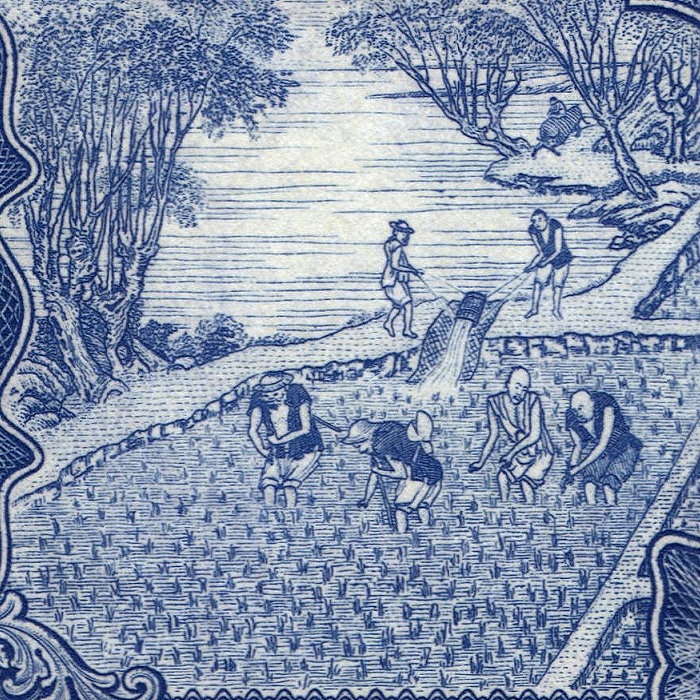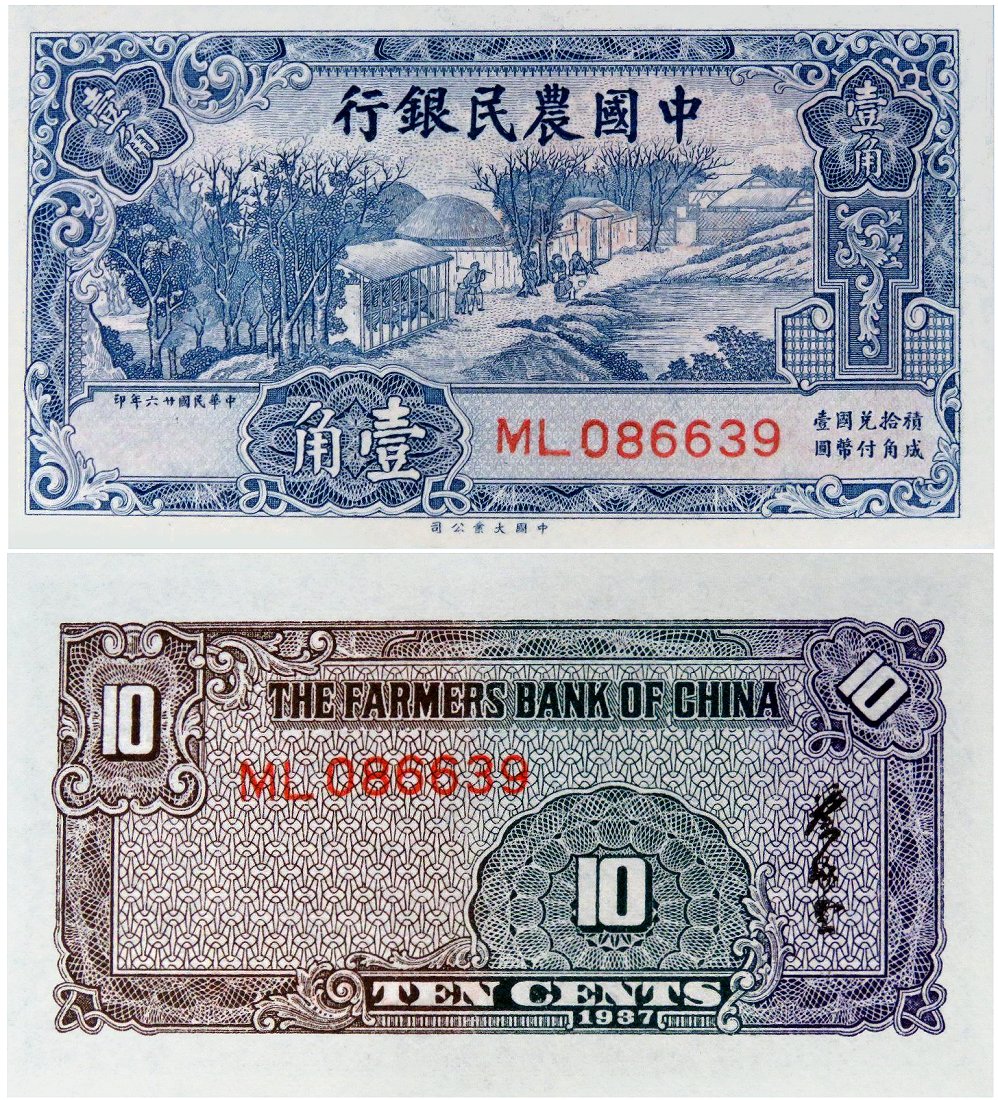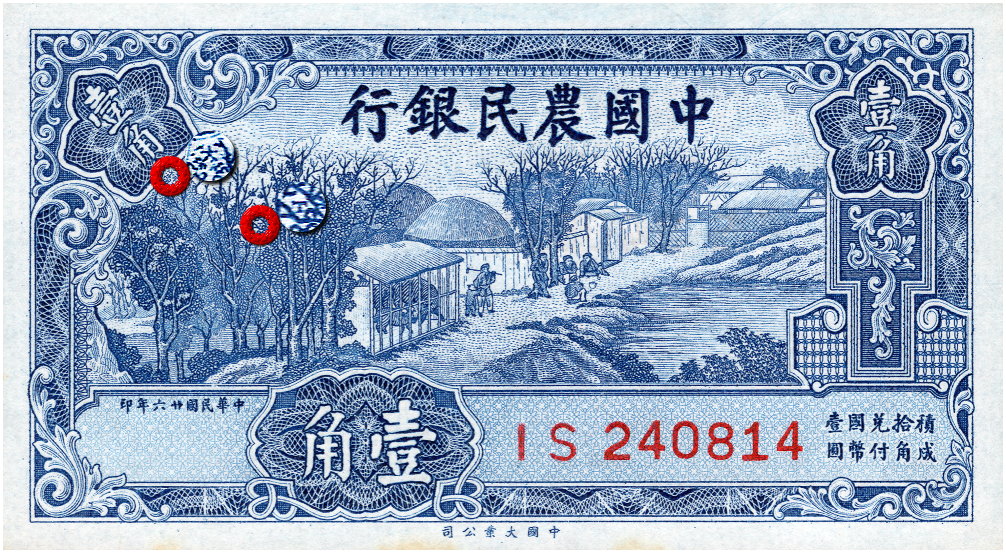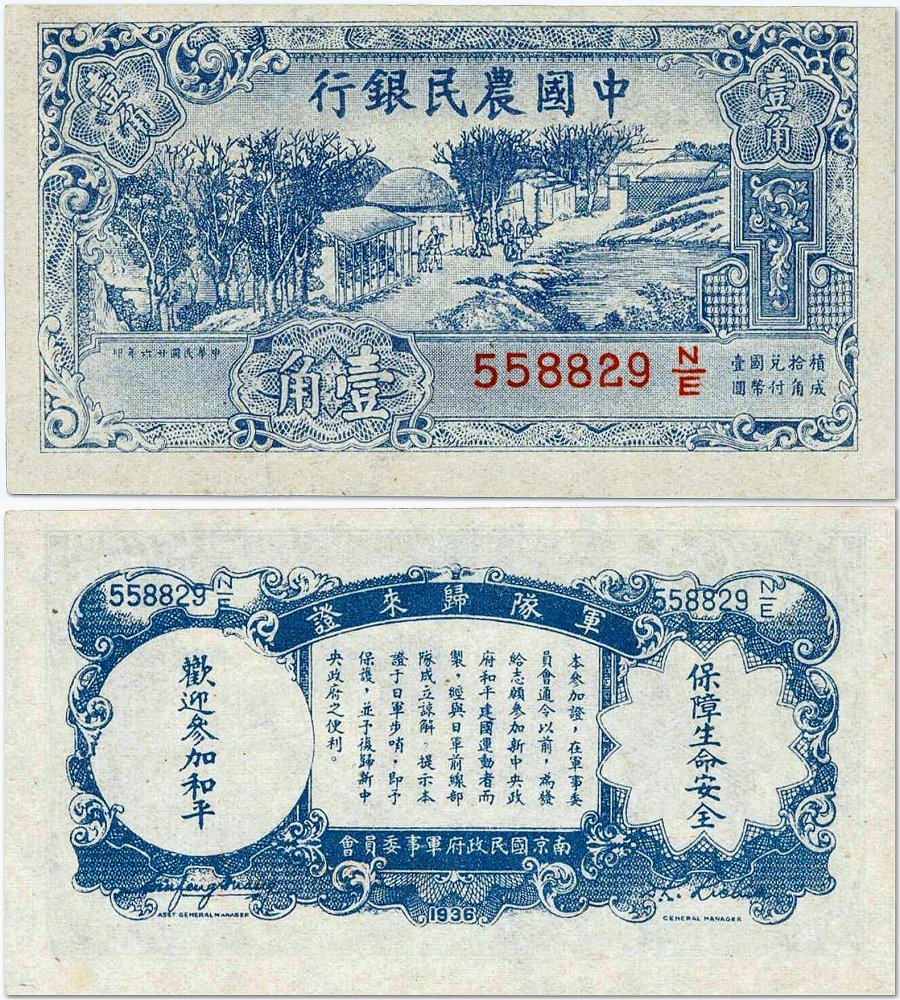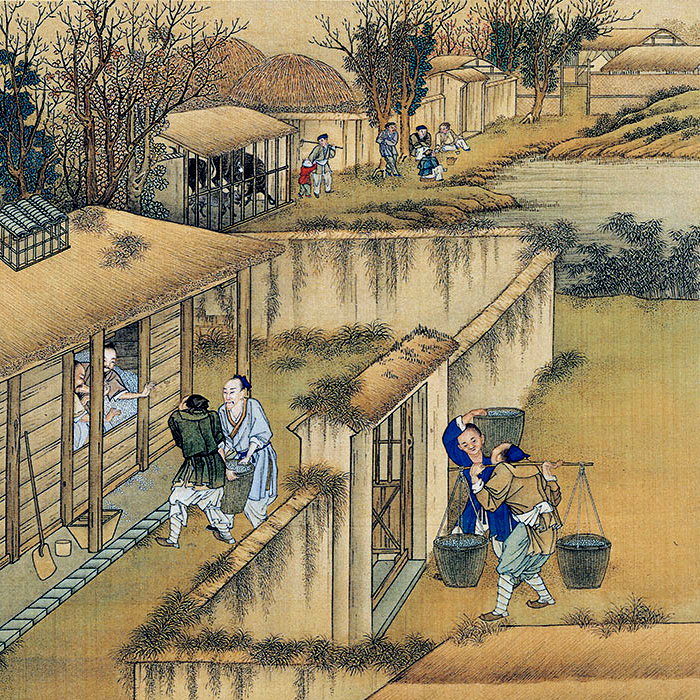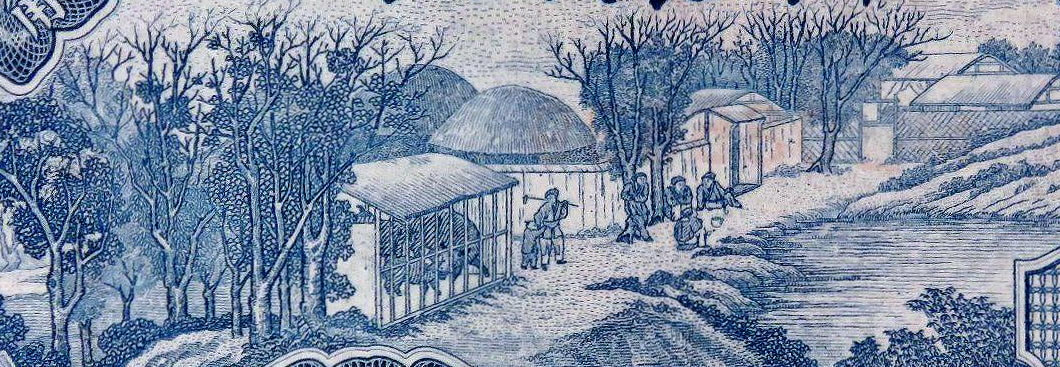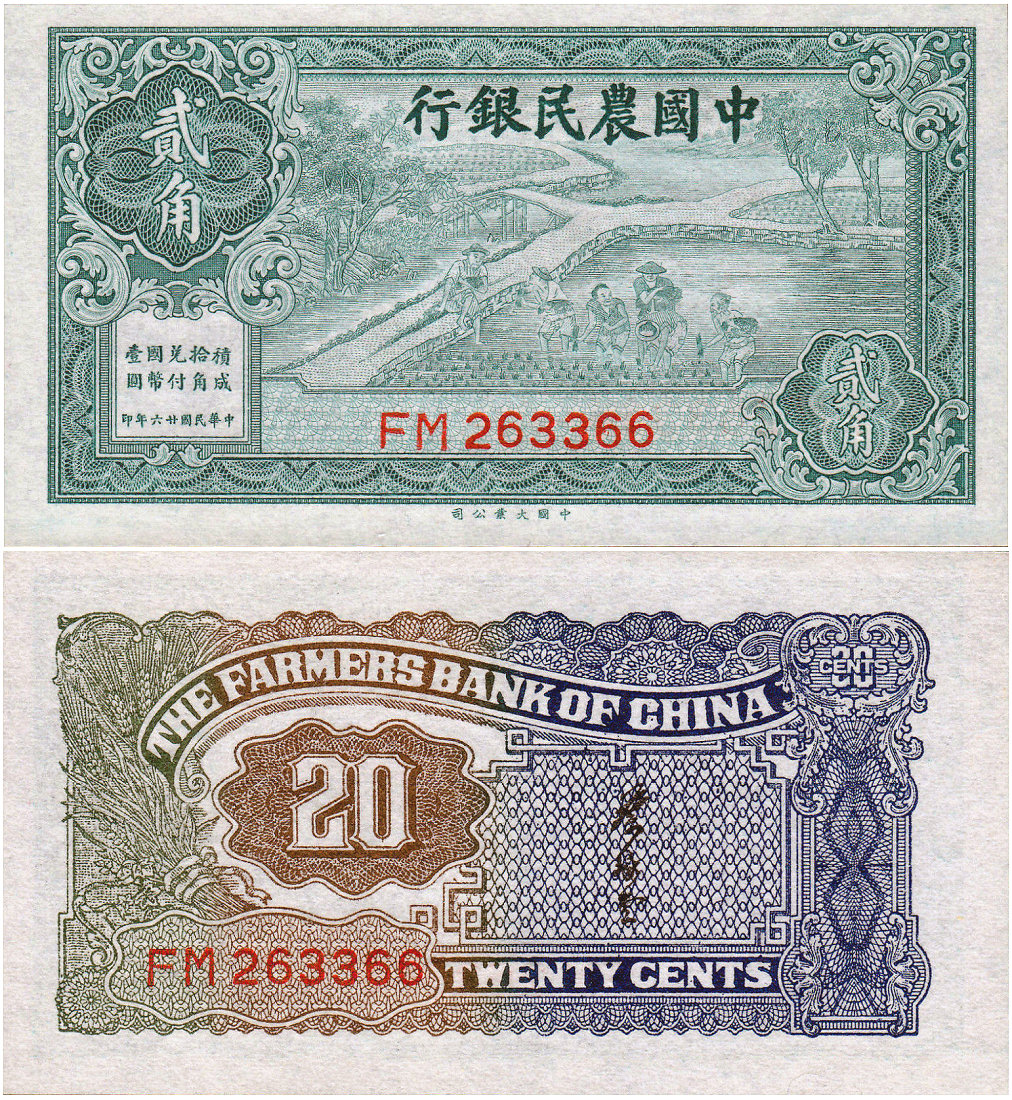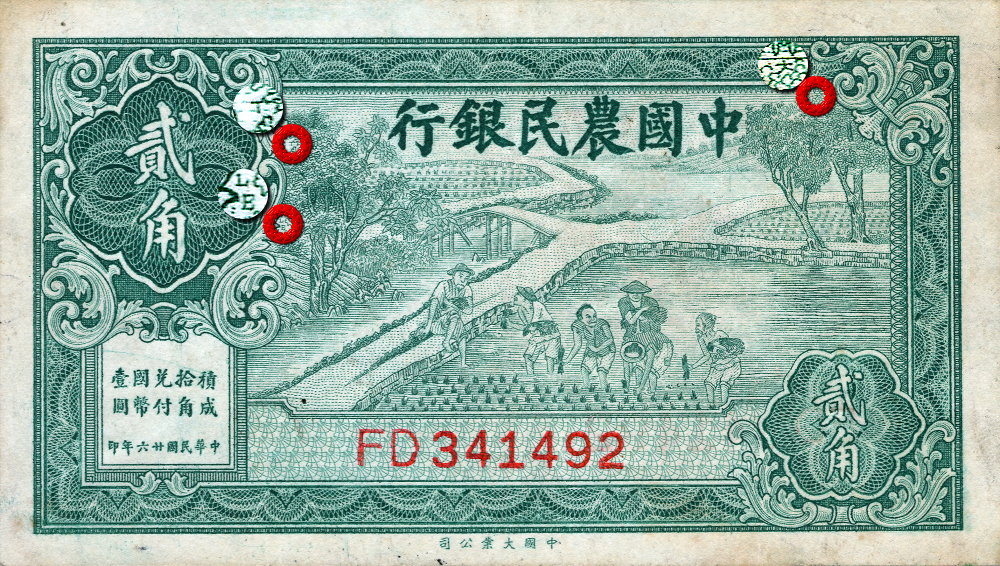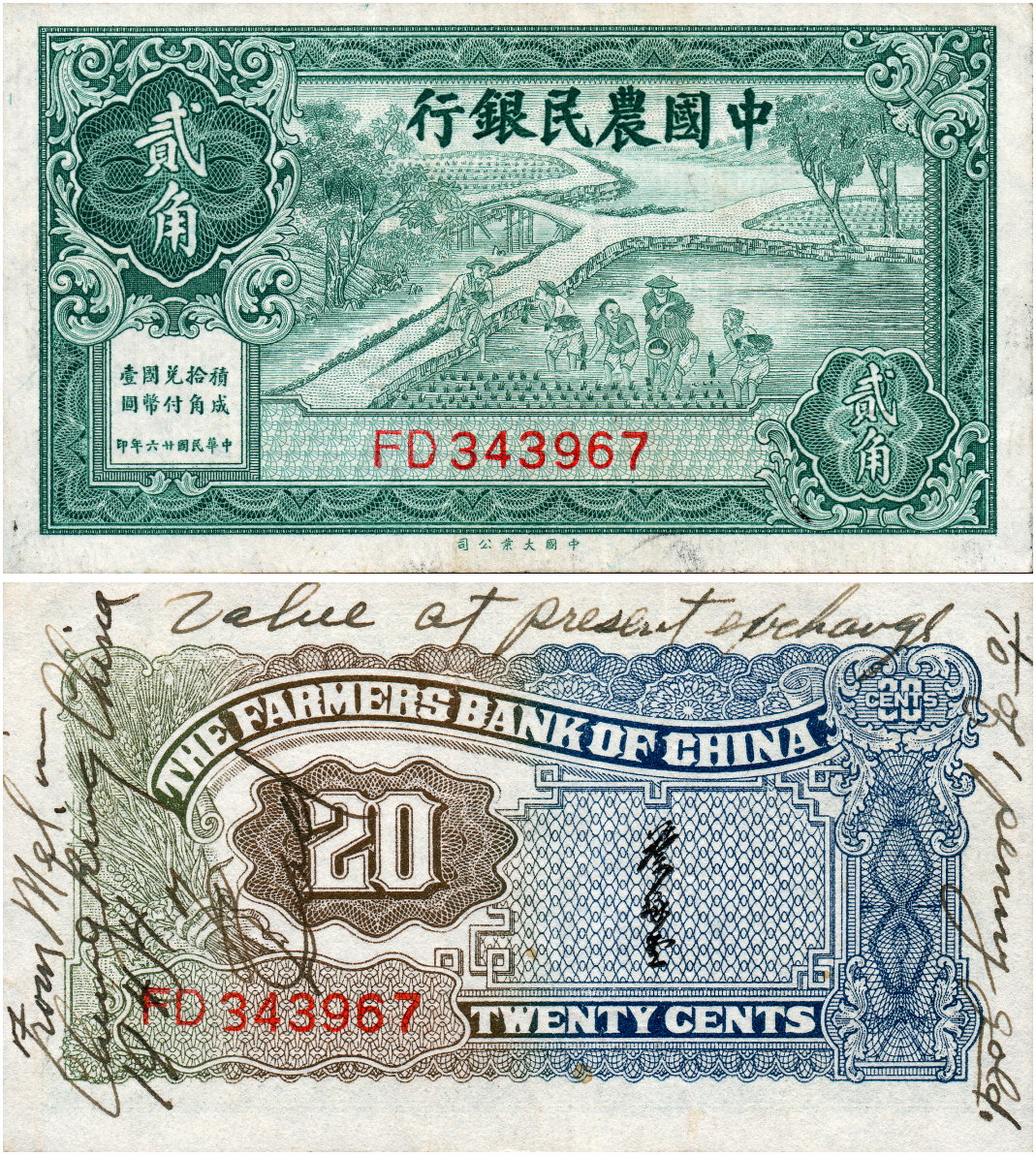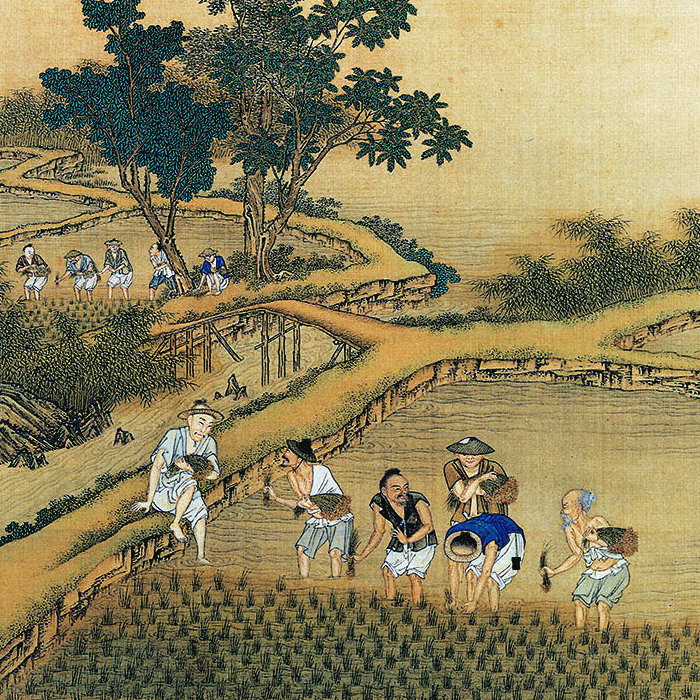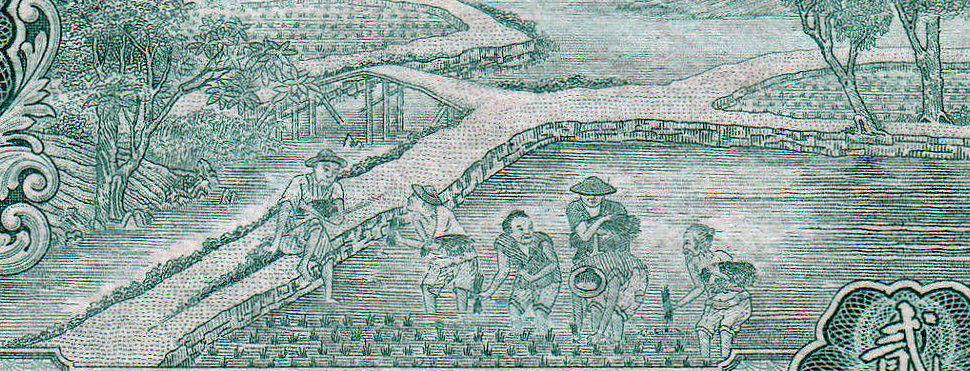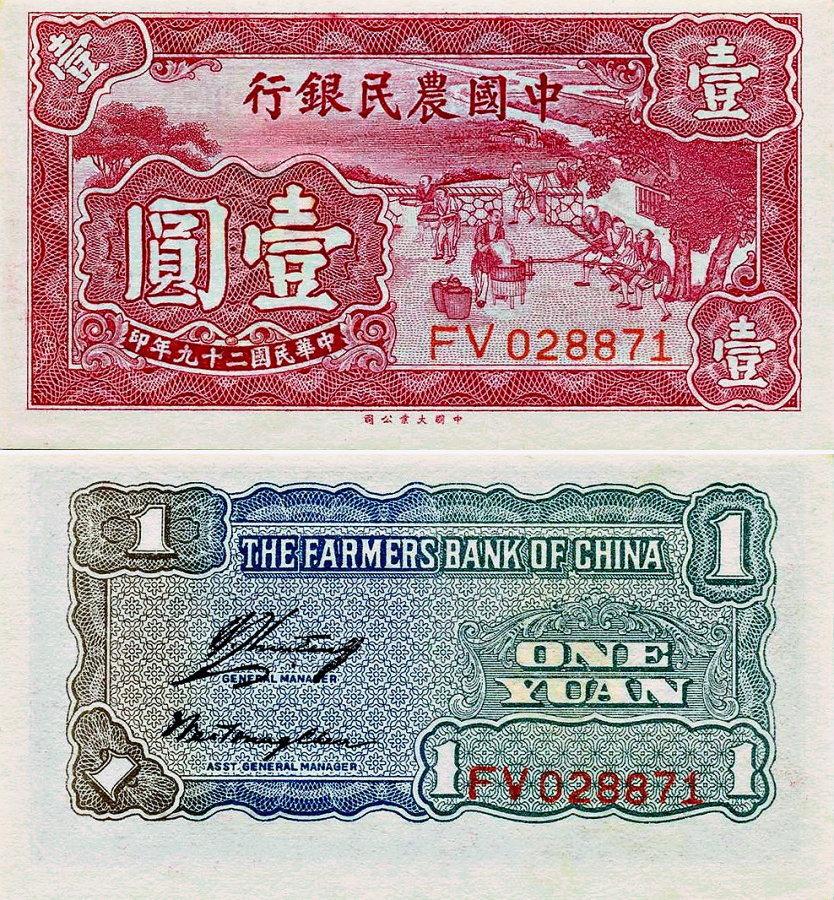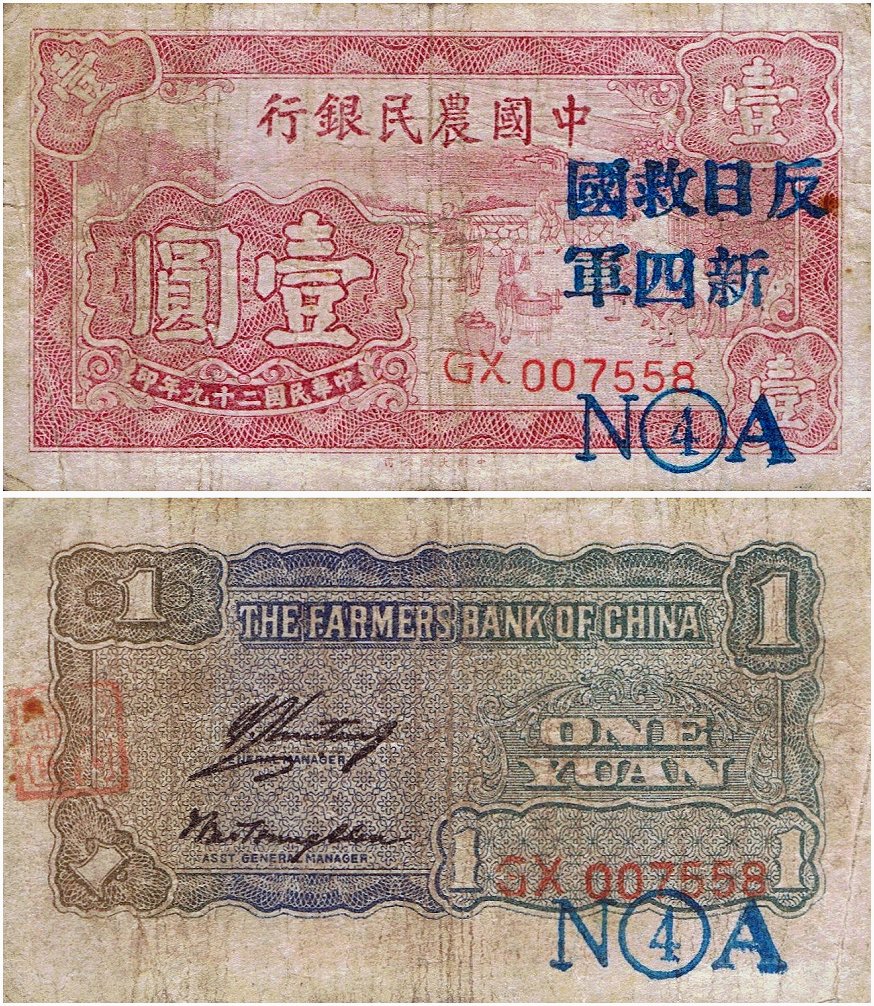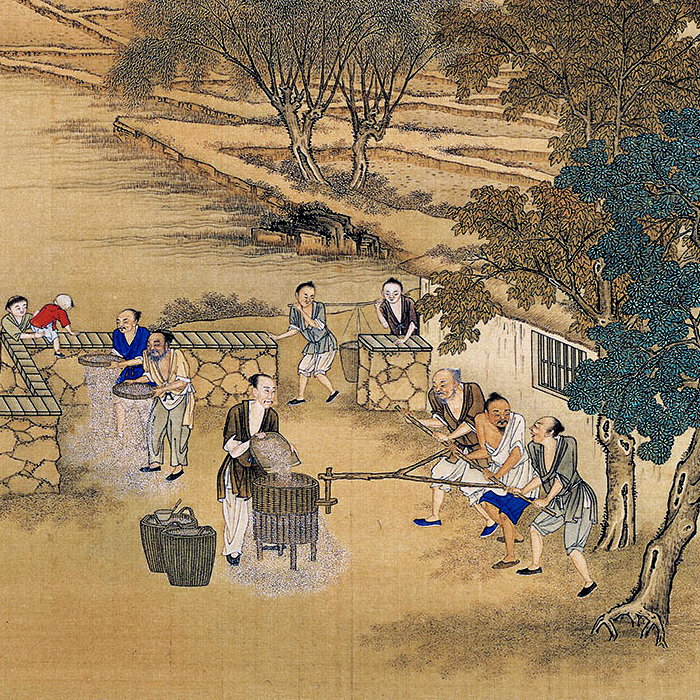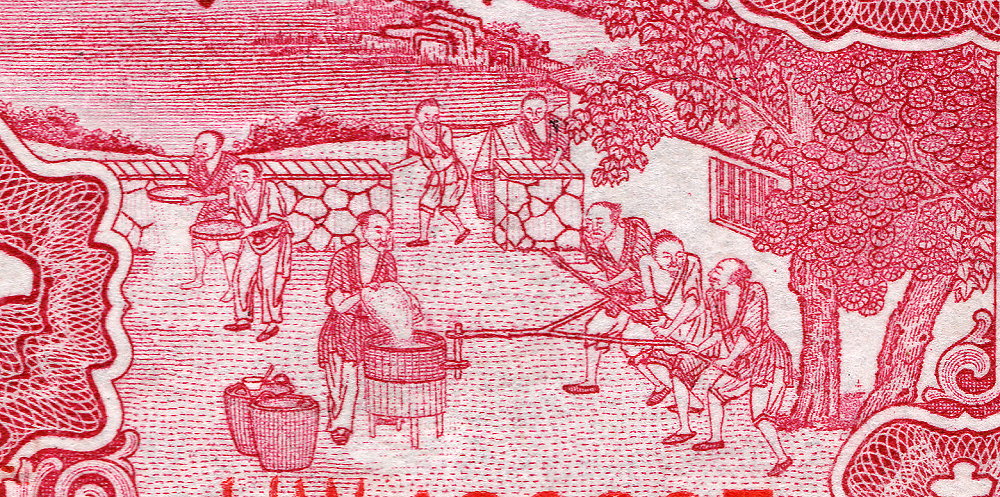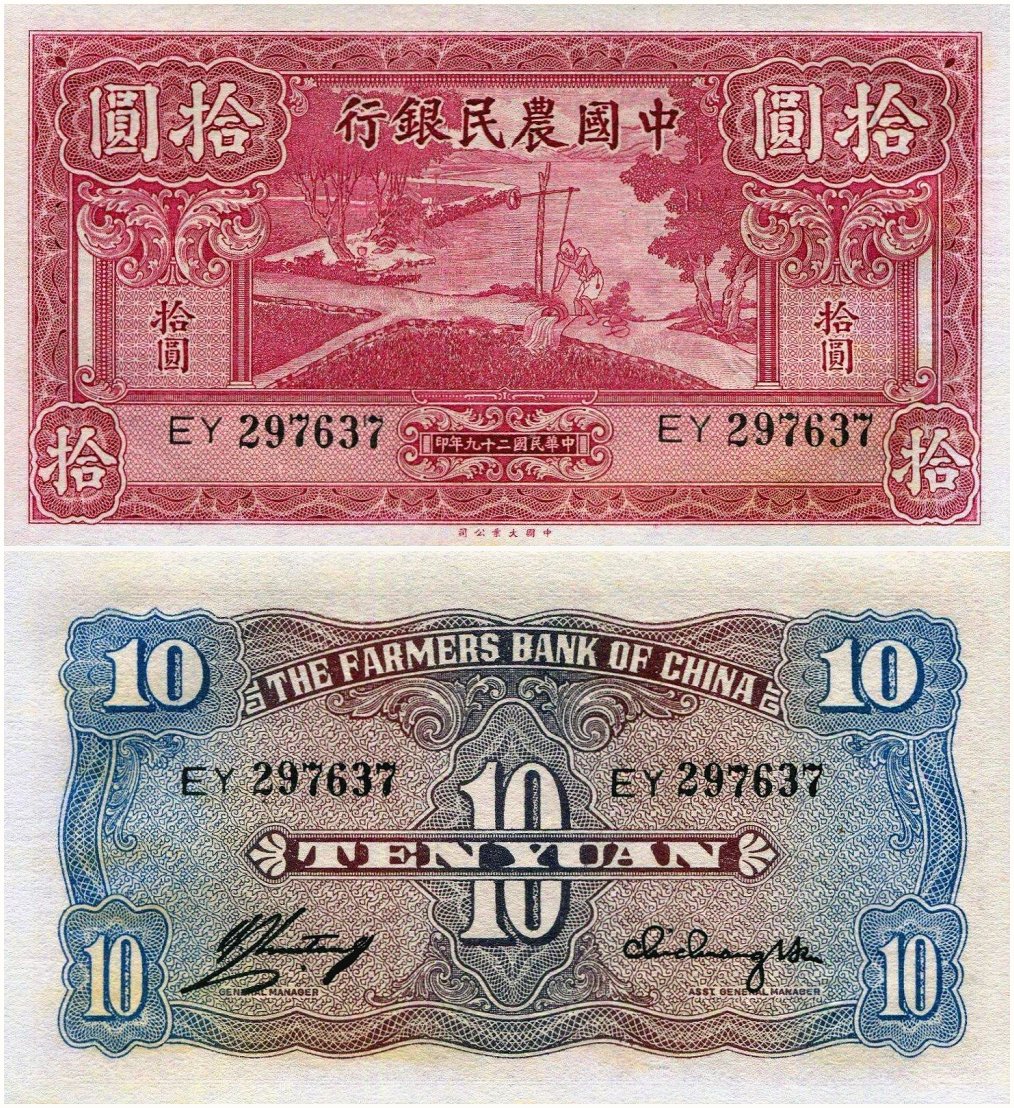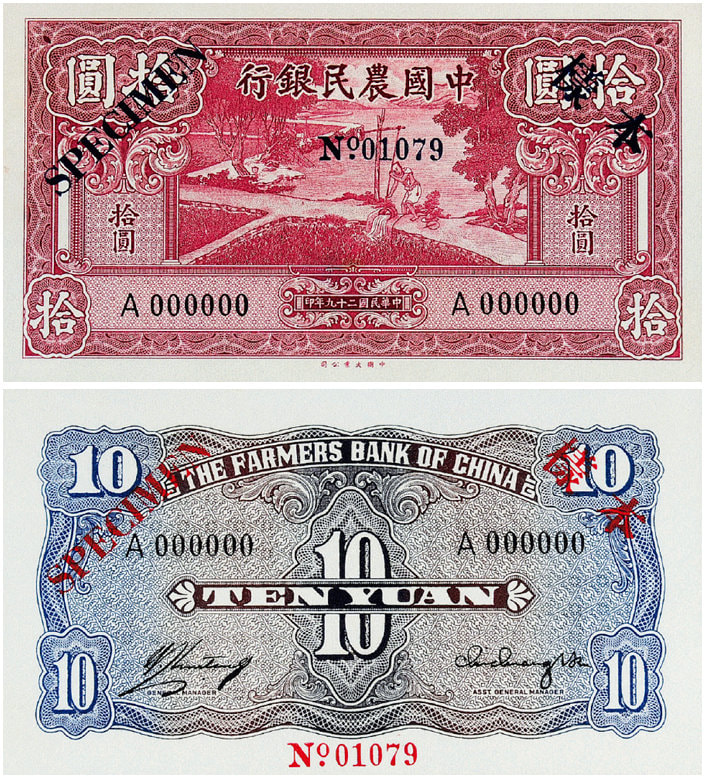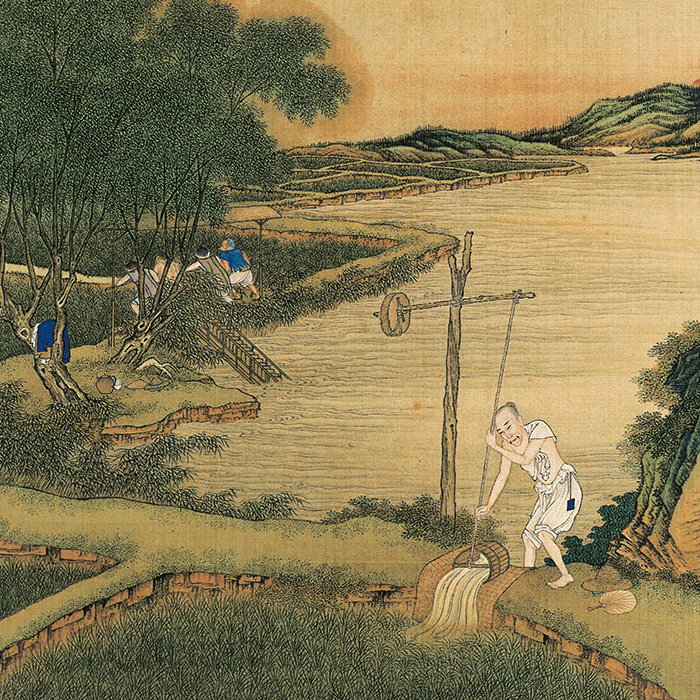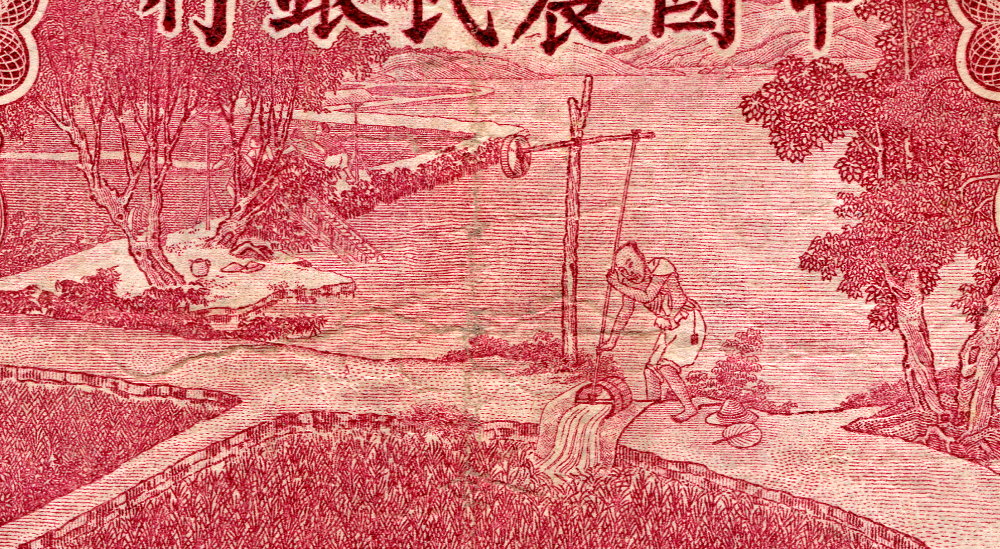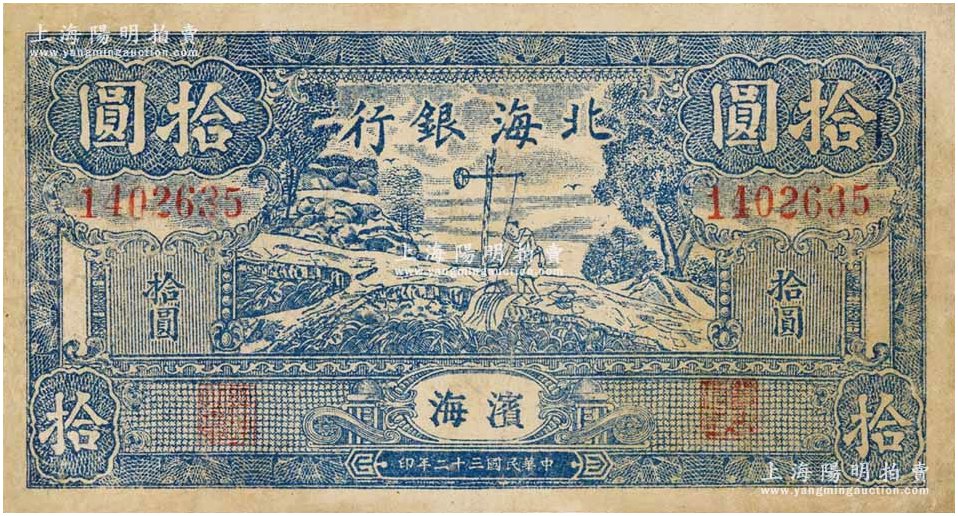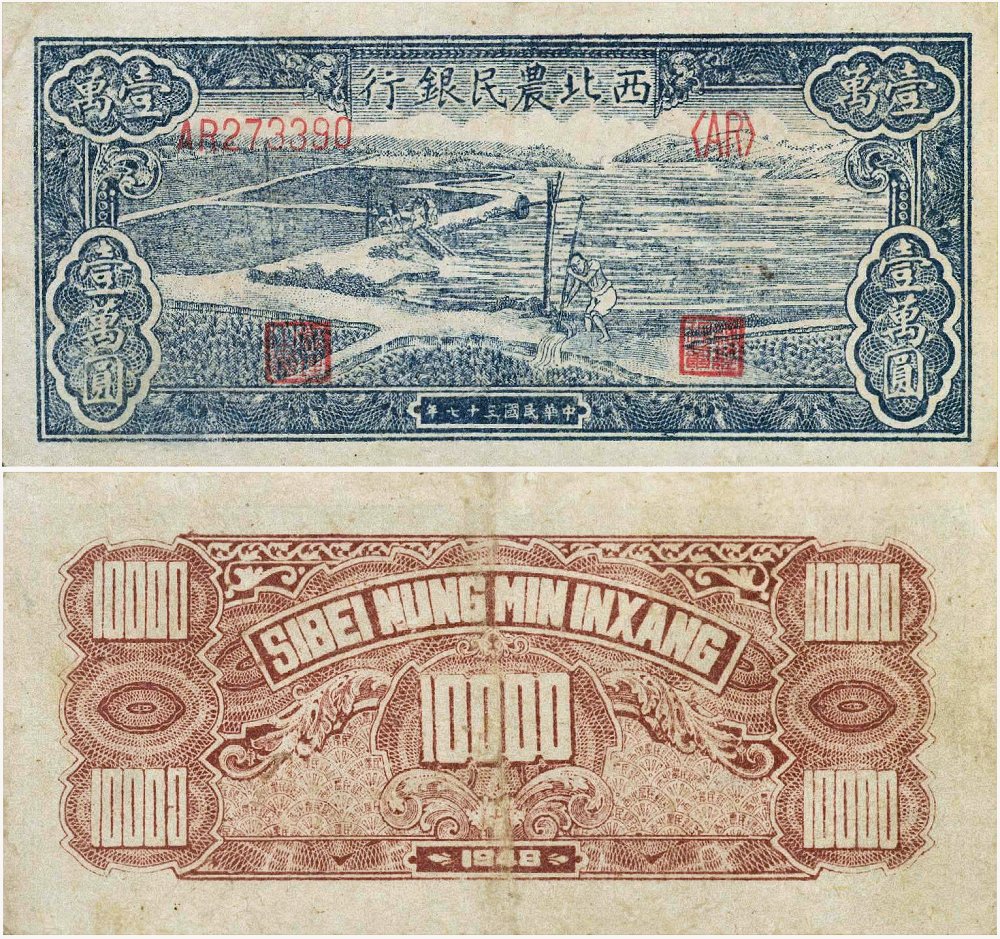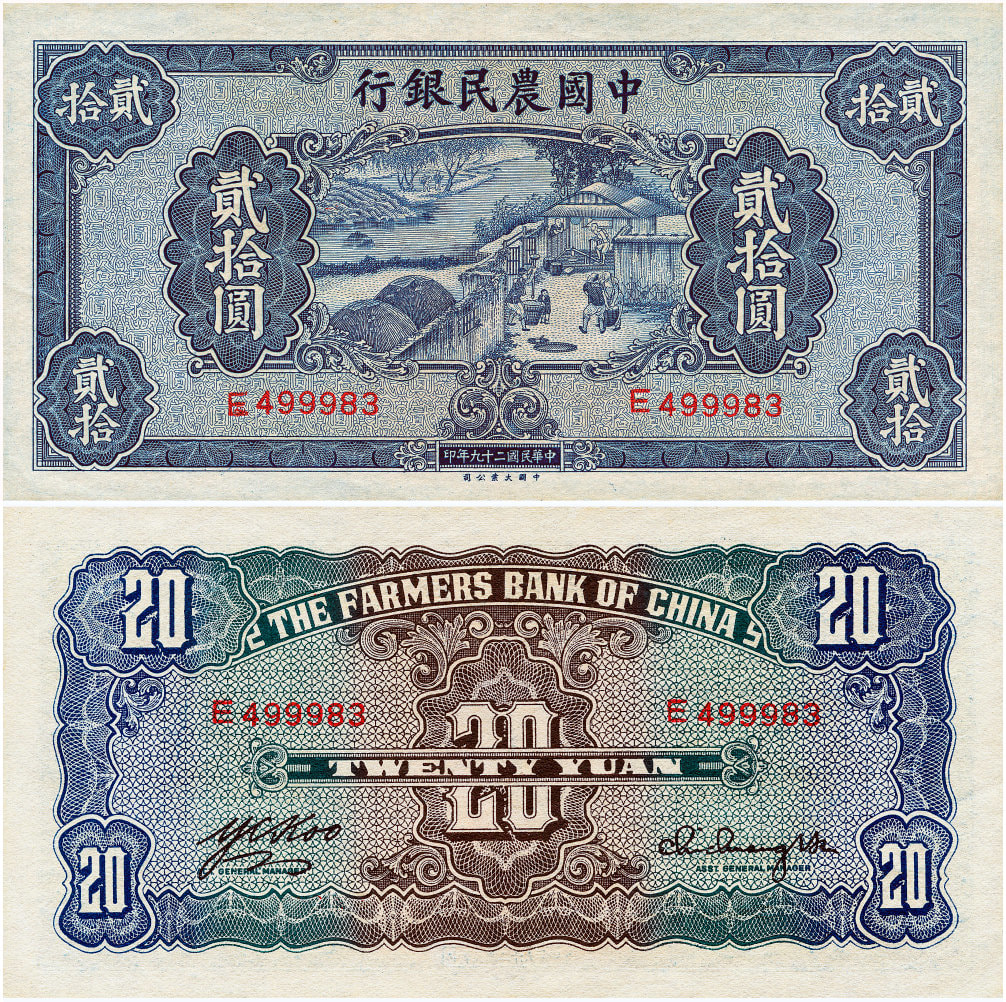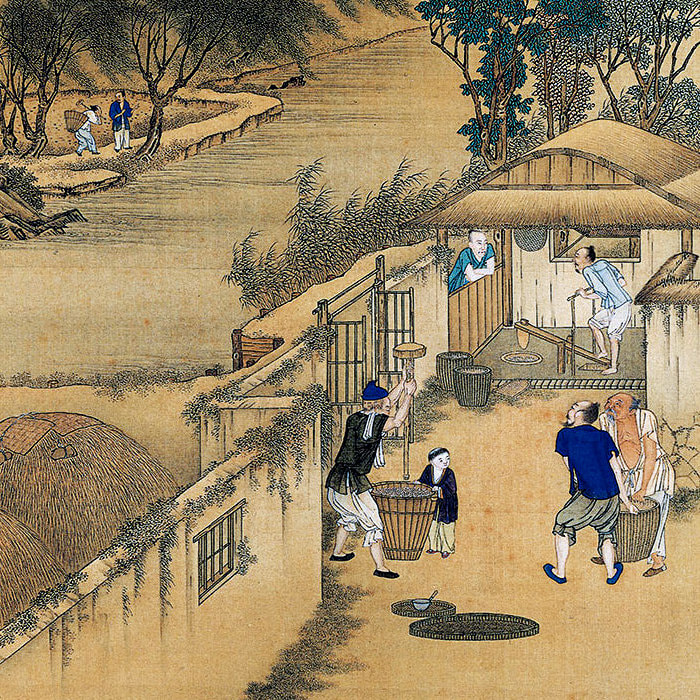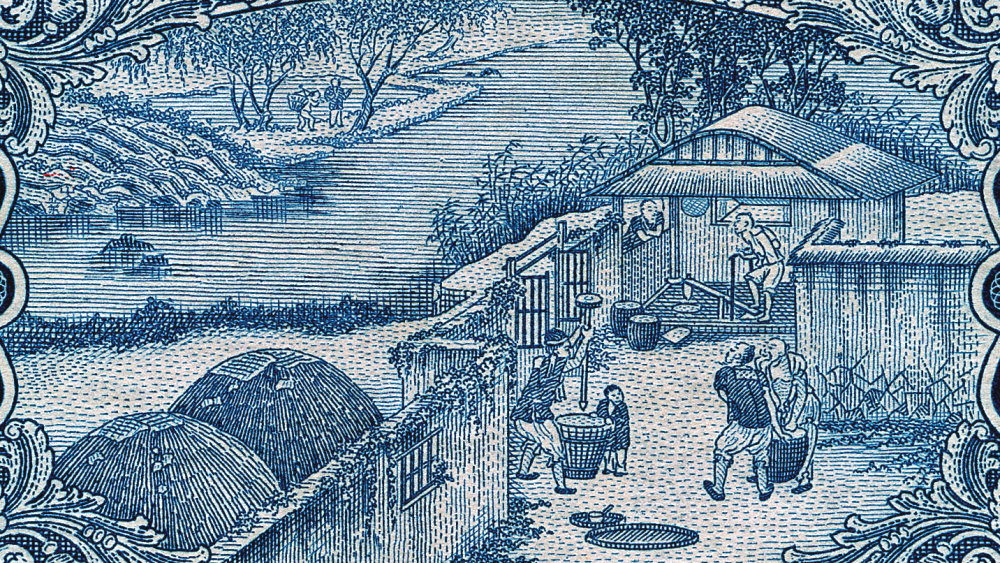|
January 2019
|
The Farmers Bank of China - 中國農民銀行
Section 2
The 1936 De La Rue issue - 年五十二國民華中
Stylistically part of the 1935 series, this single 1936 issue by the Farmers Bank still has the cartouches at the left and right of the front for branch names, but unlike the 1935 issues, lacks any obvious provision for the application of seals.
|
50 cents (National Currency)
Blue.
(front) ‘classical’ agricultural scenes originally from the Southern Song Dynasty 'Yuzhi gengzhi tu' (Imperially Commissioned Illustrations of Agriculture and Sericulture/Tilling and Weaving). (back) the Liuhe Pagoda of Hankou (Hangzhou), at centre and a horned goat. - Further details below. Watermark: none Printer: Thomas De La Rue & Company Ltd, London. 德纳罗印钞公司 Type 1 (Krause SCWPM P 460, Smith & Matravers C290-40). Signatures: Xu Jizhuang (General Manager) - Chen Huaizhong (Assistant Gen. Manager) Type 2 Specimen Right: a contemporary counterfeit, and well circulated despite being an obvious fake when compared with a genuine example. |
The back and front vignettes of the 50 cents:
The back:
The back:
|
The Liuhe Pagoda of Hankou (Hangzhou), also known as the Six Harmonies pagoda, is located on Yuelun Hill overlooking the Qiantang River. It was originally constructed in 970 by the Wuyue Kingdom, destroyed by warfare in 1121, and reconstructed fully by 1165, during the Southern Song dynasty (1127–1279). The pagoda derives its name from the six Buddhist ordinances. Legends have it that the pagoda was built in order to calm the tidal waters of the Qiantang River which it overlooks, and as a navigational aid. The historian and sinologist Joseph Needham identified it's secondary use as a permanent lighthouse. Though appearing as being of 13 stories, there are only seven levels to the pagoda. The pagoda was in a ruinous state by the early 19th century, and subsequently restored. It has been further restored since and still stands. |
The pagoda appears on various Chinese banknotes including Central Bank of China issues of the 1940s and many notes of Chekiang Province (Zhejiang) in which the pagoda stands.
The front:
Below: as mentioned above; the Qing/Song dynasty scenes from the 'Yuzhi gengzhi tu' which are the basis for the left and right vignettes on the front of the 1 Yuan.
The 1937 Ta Yeh (Dah Yip) Company issue - 年 六十二國民華中
As with the issues printed by the London UK company De La Rue, the front vignettes are too based on images from the 17th century recreation of the Song dynasty work 'Imperially Commissioned Illustrations of Agriculture and Sericulture' 御製耕織圖 'Yuzhi gengzhi tu' (胤禛耕织图册·收刈). Unlike those however, these only carry a vignette on the front and are less direct representations, with details added or taken away. This was due to the very different dimensions of the vignette area.
|
10 cents (National Currency)
Blue. (front) ‘classical’ agricultural scenes originally from the Southern Song Dynasty 'Yuzhi gengzhi tu' (Imperially Commissioned Illustrations of Agriculture and Sericulture/Tilling and Weaving). (back) borders, English title and denomination. - Further details below. Watermark: none Printer: Ta Yeh (Dah Yip) Co. Type 1 (Krause SCWPM P 461, Smith & Matravers C290-50). Signatures: Script signature of Ye Zuotang (General Manager) Type 2 Specimen Right: the locations of two hidden marks left by the engraver on the front of the note; a chinese character and a letter 'T'. Right: This design was also used for a Nanking Military pass (shown right). This note appears as the third known in a series of Japanese propaganda 'parody' issues. It bares the correct face though the format of the serial number is wrong - the reason being that it was intended to match that of the reverse. The reverse is yet another scaled down version of that used on the original parody note of the Central Bank of China 1 yuan of 1936, and even retains the signatures of the Central Bank of China officials. A second version of this note has had the date altered to 1942. |
The front vignette of the 10 cents:
|
Left: the full illustration, showing that the engravers used the background scene for the vignette, and completed the top of the trees and added a visible end wall to the upper right most building (above). More noticeably however, they removed any trace of the foreground buildings, adding the lower tree trunks, the obscured corner of the cattle pen, and more of the river bank. |
|
20 cents (National Currency)
Green. (front) ‘classical’ agricultural scenes originally from the Southern Song Dynasty 'Yuzhi gengzhi tu' (Imperially Commissioned Illustrations of Agriculture and Sericulture/Tilling and Weaving). This appears to depict rice planting. An extended version of this scene appears on the 100 yuan of 1942 (see Section 3). (back) borders, English title and denomination. - Further details below. Watermark: none Printer: Ta Yeh (Dah Yip) Co. Type 1 (Krause SCWPM P 462, Smith & Matravers C290-51). Signatures: Script signature of Ye Zuotang (General Manager) Type 2 Specimen Right: the locations of three hidden marks left by the engraver on the front of the note; a chinese character at right and letters 'T', plus 'L' and 'E'. Right: an annotated example of this note, sent as a souvenir by a US serviceman back to his father. "From Mel in Chungking China 1944 - To Dad. Value at present exchange 1/10th of 1 penny gold." |
The front vignette of the 20 cents:
|
Left: the full illustration, showing that the engravers used the foreground scene for the vignette, and drastically changed various background details, such as removing any trace of the distant group of labourers and trees and adding new trees in the middle ground. The new tree at the left (above) is a scaled own version of the right hand tree shown in the original illustration. |
The 1940 Ta Yeh (Dah Yip) Company issue - 年 九十二國民華中
This series continues on the theme of the Song dynasty work 'Imperially Commissioned Illustrations of Agriculture and Sericulture' 御製耕織圖 'Yuzhi gengzhi tu' (胤禛耕织图册·收刈).
|
1 yuan (National Currency)
Red.
(front) ‘classical’ agricultural scenes originally from the Southern Song Dynasty 'Yuzhi gengzhi tu' (Imperially Commissioned Illustrations of Agriculture and Sericulture/Tilling and Weaving). (back) borders, English title and denomination. - Further details below. Watermark: none Printer: Ta Yeh (Dah Yip) Co. Type 1 (Krause SCWPM P 463, Smith & Matravers C290-60). Signatures: Ye Zuotang (General Manager) - Chen Huaizhong (Assistant Gen. Manager) Type 2 Specimen There is only one known hidden mark; a tiny 'L' located in the border below the '中' character in the date panel. Right: a very worn example of the 1 yuan with an interesting overprint which translates to "Anti-Japanese New Fourth Army" The New Fourth Army (N4A) was a unit of the National Revolutionary Army of the Republic of China established in 1937. Unlike most of the National Revolutionary Army, it was controlled by the Communist Party of China and not by the ruling Kuomintang, and was part of the 'United Front' against Japan. However friction between the Nationalists and Communists led to a battle between the New Fourth Army and Nationalist troops in 1941. The N4A was defeated. This incident led to the effective end of cooperation between the two factions. |
The front vignette of the 1 yuan:
|
10 yuan (National Currency)
Red. (front) ‘classical’ agricultural scenes originally from the Southern Song Dynasty 'Yuzhi gengzhi tu' (Imperially Commissioned Illustrations of Agriculture and Sericulture/Tilling and Weaving), depicting a farmer irrigating a rice paddy. (back) borders, English title and denomination. - Further details below. Watermark: none Printer: Ta Yeh (Dah Yip) Co. Type 1 (Krause SCWPM P 464, Smith & Matravers C290-65). Two known serial varieties. Signatures: Ye Zuotang (General Manager) - Xu Jizhuang (Assistant Gen. Manager) Type 2 Specimen - shown right. |
The front vignette of the 10 yuan:
|
Above: the front vignette was later copied for the front of issues by the communist Farmers Bank of the North-West (see below).
Left and above: the image has been altered considerably for use on the banknote. The background landscape has been lowered and the details changed - such as the addition of an extra hill. Completely new trees have been added to the right. One of the labourers has been removed from the left side tree. |
|
20 yuan (National Currency)
Blue.
(front) ‘classical’ agricultural scenes originally from the Southern Song Dynasty 'Yuzhi gengzhi tu' (Imperially Commissioned Illustrations of Agriculture and Sericulture/Tilling and Weaving), depicting a farmer irrigating a rice paddy. (back) borders, English title and denomination. - Further details below. Watermark: none Printer: Ta Yeh (Dah Yip) Co. Type 1 (Krause SCWPM P 465, Smith & Matravers C290-70). Two known serial varieties. Signatures: Gu Yiqun (General Manager) - Xu Jizhuang (Assistant Gen. Manager) Type 2 Specimen |
The front vignette of the 20 yuan:

